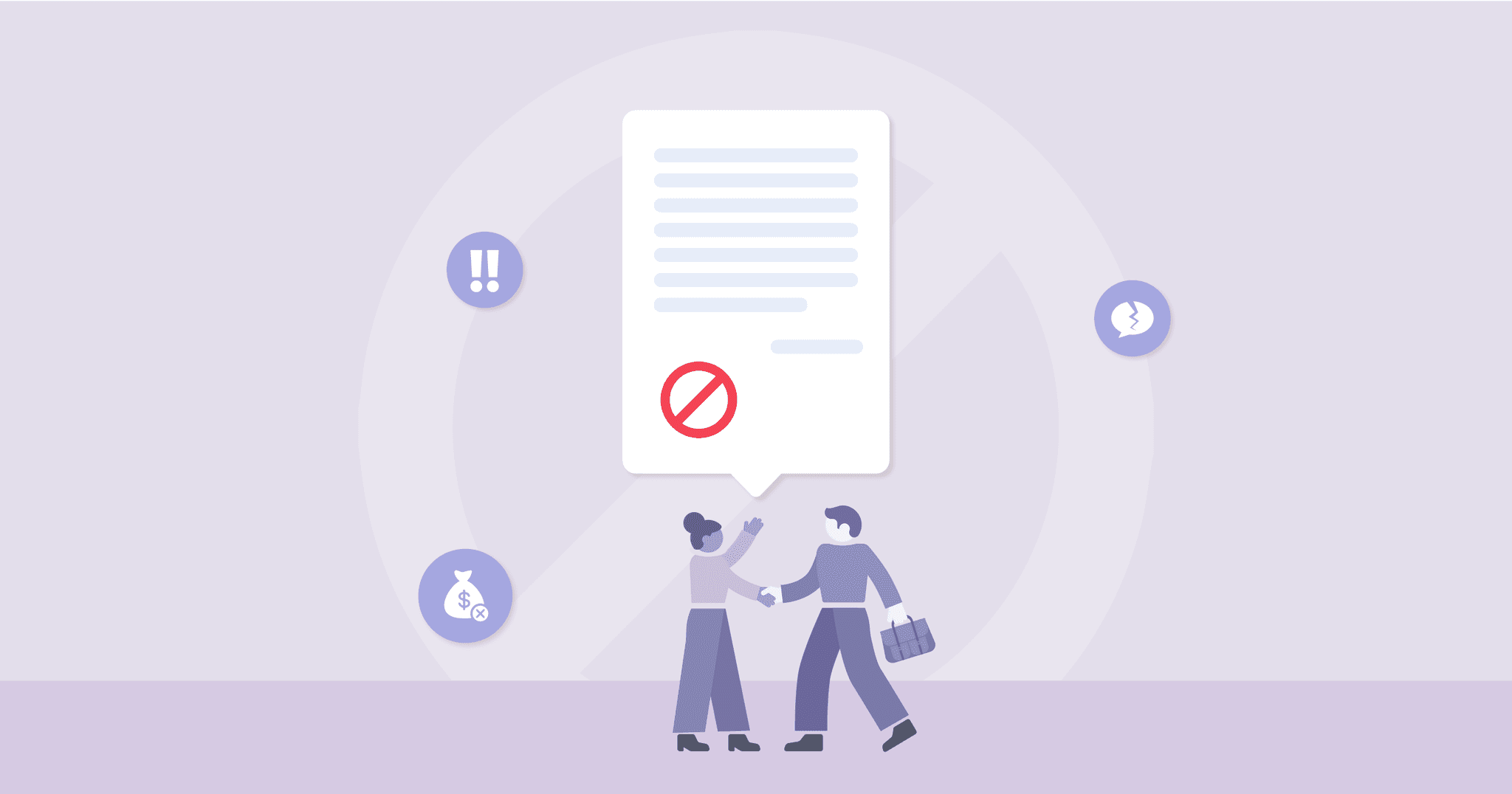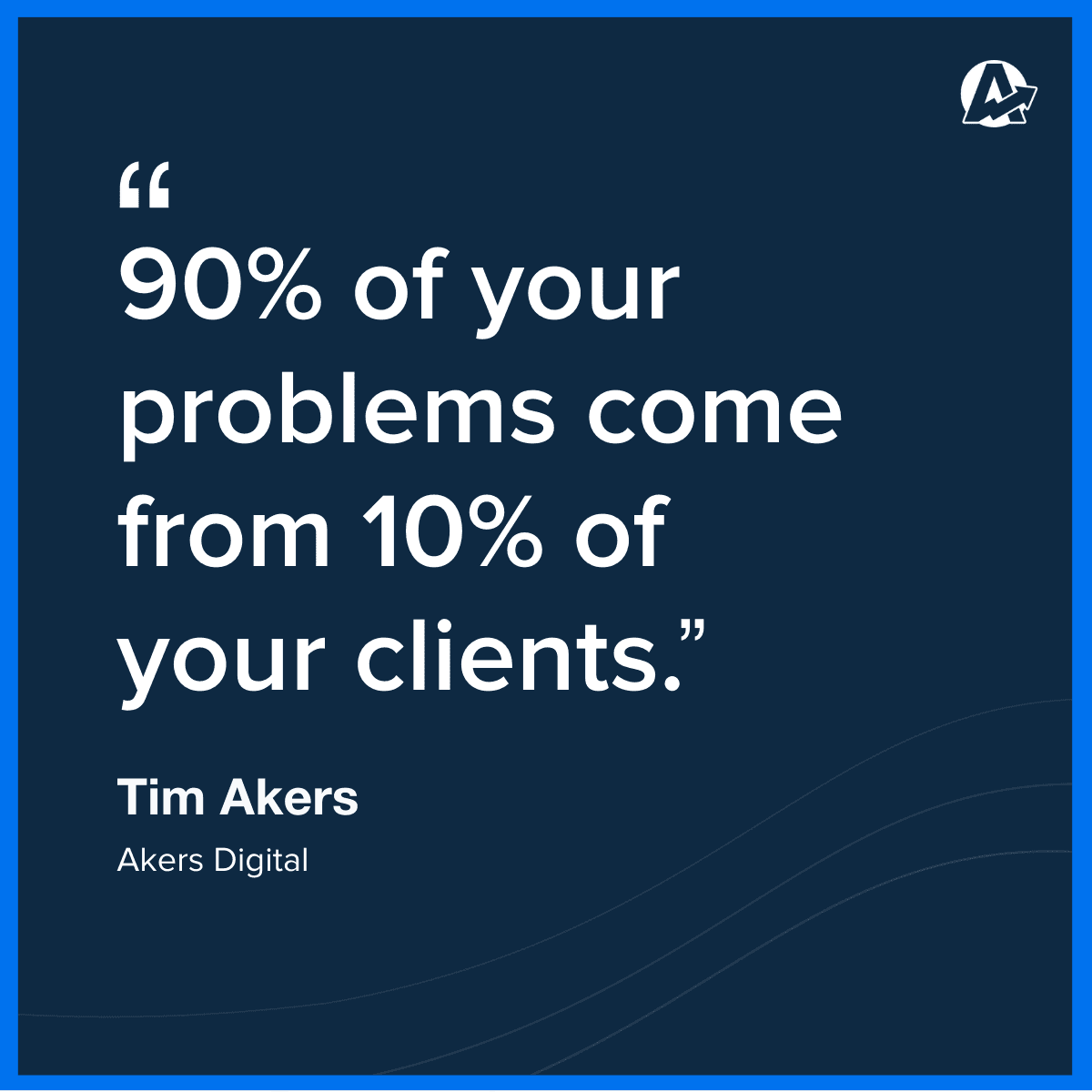
QUICK SUMMARY:
Terminating a relationship with a client when it no longer benefits your marketing agency involves a tactful approach. This guide outlines how to fire a client smoothly, focusing on maintaining professionalism and mitigating negative impacts. It offers practical advice to enhance your agency's future client interactions and growth.
Are you frustrated with a particular client?
Do you imagine how wonderful life would be without them?
Sometimes client relationships go sour. This can happen early in the relationship. But it may also deteriorate even after years of working together.
The thing is, once a client relationship goes bad, it begins to threaten your agency.
Over time, this negative client relationship affects your other accounts too.
That's why, sometimes, you have to make a tough call and fire a client. Considering a client exit interview could provide valuable insights for your agency's growth.
It's probably not something you find easy. So, in this post, we'll share a few ideas on how to fire a client. You'll learn how to do it peacefully, gracefully, and without unpleasant consequences for your agency.
Let's begin.
How To Be 100% Sure That You Must Fire the Client
Let us make something clear:
Not every seemingly bad client relationship must end.
In fact, just because you face problems with a client, it doesn't mean they have to go.
Perhaps, you and the client could work out the challenges you face. An honest conversation might save your agency from losing an account. And then having to find a new client to replace them.
Ego, unfortunately, could be the culprit too. It's common to see agency owners getting frustrated with clients to the point of letting them go just because:
A client asked for a revision out of the project scope. It wasn't an unreasonable demand, mind you. The founder was just too busy to do it, and their response was anger.
Or acted in a similar way after a client rejected their idea.
You get the picture.
Pricing is another issue. Many agencies consider firing clients just because they're on legacy rates and there's a dent in cash flow. They rarely consider the alternative though—upgrading those accounts to new prices.
But we'll admit, sometimes client relationships deteriorate beyond rescue. And when they do, they threaten your agency.
Founder of Kōvly Studio, Brittany Woitas, says life is too short to continue a relationship with a problem client.
If it feels like it isn't the right fit, end the relationship, period. In my experience, each time I've made this call, it's opened up room for a new opportunity with an ideal client."
- Brittany Woitas, Founder at Kōvly Studio
Creating Healthy Business Boundaries
So, what are those boundaries? Here are the most common ones:
Broken Client Communications
Imagine you work on the client's projects but get little or no support or interest from them. You keep reaching out to them, week after week after week. Eventually, you hit a wall and need their input. But there's none.
You may feel your time would be better spent on other accounts, right? And, most likely, as a business owner with many other priorities, you'd be right.
Agency Tip: If you're struggling with communicating your clients' marketing data and metrics, try a different approach. Data storytelling is an essential skill every marketing agency needs to adopt to build transparency and improve client communication.

Boost client communication and engagement with annotations and goals in your client reports. Visually demonstrate your agency's value. Start your 14-day free trial today.
Unrealistic Demands
This is such a common scenario. Some clients disregard the original scope of work. Some go even further. They become aggressive in getting their way.

This problem client may threaten you and your staff. Block payments until you do what they say. Play the blame game.
And in turn, these difficult clients drop the company's morale down.
No Support for Projects
With these clients, you find yourself running in circles. They veto all of your ideas. But they never offer any insight to get the project moving.
The result: accruing more costs. And on many levels at that—your staff has to work on new ideas all the time, often while neglecting other valuable clients too.
A New Process That Generates More Cost
This scenario often happens when you subcontract with other companies. The process you've been using to work together changes. And the new one results in spending more time and money to deliver the work.
The client might require more meetings, or more revisions, forcing you to dedicate more staff to the project too.
The best example of a bad client was when a former client called us every single day to review the leads on the first week and would find a way to tie them back into him and how this isn't counted as our lead. He told us that because he sat next to the lead's grandad's next-door neighbor in church, that meant it was his lead and not ours. This was the end of that relationship."
- Ben Spray, Managing Director at We Are Marketable
Poor Anger Management
Abuse towards you or your team member. Bad temper. Attitude. None of these make up a great client either. And certainly, your staff shouldn't be subjected to any such behavior from nightmare clients.
We have a firm policy around mutual respect between our team and our clients. If we feel that line has been crossed, we unapologetically terminate that client by simply stating that we are no longer the right fit for each other. From there, we share all assets with the client and clearly outline any applicable next steps, and end the relationship.
- Brittany Woitas, Founder at Kōvly Studio
Late Payments
Nobody likes to chase invoices constantly. Not to mention struggling with the cash flow as a result. Although, in many cases, you can overcome this challenge, some clients remain bad payers. And sometimes, it may make more sense to replace them with someone else.
If any of the above happens to you regularly, it might be time to fire bad clients.
I can't think of any pros for keeping a toxic client. Even though it may make the invoiced sales figure higher, they will often withhold payment for petty reasons or even end up asking for a credit or compensation.
- Daniel Noakes, Founder of UClimb
Don’t Waste Another Billable Hour on Manual Reporting!
Try AgencyAnalytics Free for 14 DaysHow to Fire a Client
In this section, we'll discuss two things:
1. How to End the Client Relationship: We'll cover what you should and shouldn't do to avoid any unpleasant consequences for your agency. After all, you don't want any hassle from a toxic client after you let them go. People talk and work gets around.
2. How To Tell a Client You’ve Fired Them: This, by far, is often the trickiest part. We'll look at three approaches you could take here.
Here are the best ways to let them go.
How to End a Client Relationship
Here's what NOT to do:
Never Blame or Offend the Client
Even though bad clients might be at fault, try to push the blame somewhere else.
Do Not Fire Them Without Ending Their Project First
Or at least, without identifying the steps to hand it over to whoever is going to be working with the client next. Even if it's time to fire a client, make sure you tie up loose ends.
Don’t Ever Get Into Any Discussions About Your Decision
Make it final. As a business owner, it's not always easy to let go of a profitable relationship. Even if you've got a longstanding working relationship, stick to your decision. Remember, there's a reason why you've resorted to this decision.
Don’t Fire Them Over Email
You might consider firing a client this way. But meet with them face-to-face or have a phone call. Even if only to discuss their project's completion, account hand-over, etc.
And here's what you SHOULD do:
Create the Final Task List for You and the Client
Include all things each side would have to do before firing a client. On your side, it could include the final tasks on a project, preparing documentation to hand it over, a list of assets, etc. On the client side, what documents do they need to sign off, remaining payments, etc?
Suggest Your Replacement
Recommend another agency, small business, or freelancer who you think could take over their business. Now, you don't have to make any recommendations when firing a client. But it's always worth helping them look for another agency. Call it good karma or whatever you want, it works.
How To Tell a Client That They’re Fired
We've already mentioned the best approach to fire a client: never blame them. Losing an agency might be stressful enough. Hearing that it's their fault might only aggravate them more.
So, take a different approach. Blame other circumstances, personal or business, instead.
You won't burn bridges this way. And who knows, your contact in the company might be gone in the future, and you may have a working relationship again in the future.
You'll also avoid leaving any negative attitudes towards your agency. The client will be less likely to shatter your online reputation in return.
So, what could you say instead to fire them?
Receive Agency Growth Tips, Delivered to Your Inbox
3 Approaches to Ending a Bad Client Relationship
1. Mention a Change in Personal Circumstances
Let the client know that a new personal situation might prevent you from giving your fullest attention. Caring for their business, you prefer to recommend someone else to take over (like another business or freelancer).
I've found that, in most cases, clients are quite understanding about this. They move on but retain a strong, positive attitude toward you.
We escalate to retention specialists, who try to reset the account. If this attempt fails, we offer to migrate the client to providers of their choice at no cost.
Dan Alper, VP at RankWorks
2. Changing Business Direction
Another option is to mention that you've decided to change the business focus. That way, it softens the blow and isn't as harsh as outright firing a client.
Give the client a viable explanation like moving to another industry, expanding your small business, or focusing on other services. However, for this approach to work, your new direction must sit outside of what the client would need you for.
After all, you don't want them to move with you.
I have an open conversation with them and tell them that on a business level, we can no longer work together as it's not beneficial to either party. I wish them the best for the future and we go our separate ways. Sometimes they try to come back but being honest and explaining the full reasons help both sides understand it's for the best.
- Ben Spray, Managing Director at We Are Marketable
3. Amend the Service Delivery Process, Making It Unsuitable for the Client
We'll admit this approach isn't as effective as the two above.
But when firing a client, you may not want to use your personal life as the reason. And you can't claim to have changed the business direction. For example, if you're a highly specialized agency, providing one service to a single market already. Any such claim would make no sense then, right?
In such a case, amend your pricing or how you deliver the service to make it unsuitable for the client. And in turn, let them end the client-agency relationship instead.
Now, we must warn you. This approach could backfire if they agree to new prices or processes. So, use it with caution.
Or perhaps, only when you're not 100% certain you want to fire a client.
We increase our prices to include the cash-chasing time, the time it takes to answer low-trust queries, etc. Also, while we always try to under-promise and over-deliver, we take this to extremes once we pick up a client who is a 'toxic' type. Generally, this combination of increased prices, requests for upfront payment (if there have been payment issues), and reduced promises about what results will be achieved, leads to them walking away of their own accord.
- Daniel Noakes. Founder of UClimb Ltd.
Want More Agency Leadership Tips, Delivered to Your Inbox?
Subscribe to the AgencyAnalytics Newsletter!
Conclusion
Firing a client isn't easy. The emotional weight of such a business decision can be heavy. But at the same time, toxic client relationships could affect your agency's growth.
That's why, sometimes, you have to make the tough call and recognize when it's time to let go. It's the only way to preserve your culture and find clients that are a better fit. But hopefully, you've just gained some insight into how to do this without any consequences to your agency. Good luck!

Written by
Joe started his career as a developer and since has created many internet businesses. He has now moved on to the position of CEO and has enjoyed all the challenges it has brought.
Read more posts by Joe Kindness ›Get Started for Free




